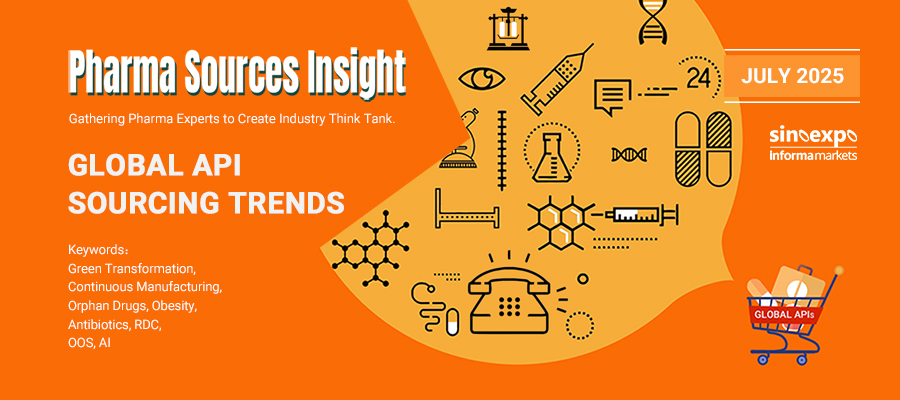Suzanne ElvidgeAugust 22, 2025
Tag: cardiovascular APIs , CNS , global quality standards
Active pharmaceutical ingredients (APIs) are the active ingredients used in pharmaceutical manufacturing and are formulated with excipients to create the finished drug form.
According to Cervicorn Consulting, the global API market was worth around $239.18 billion in 2024, and is expected to grow to $382.89 billion by 2034, with a CAGR (compound annual growth rate) of 4.82%. This growth is driven by an increasing demand for pharmaceuticals, expansion in the numbers of people with chronic and infectious diseases, and advances in research and development. Other drivers include growing numbers of prescriptions for biologics and biosimilars, as well as the increase in precision medicine. [1]
It is vitally important that therapeutics are manufactured to the highest possible quality and safety standards, particularly those that are used for very vulnerable patients. This includes preventing impurities that can risk patients’ safety, maintaining consistency between manufacturing batches, avoiding poor quality APIs that could affect the final formulation, and ensuring the correct levels of potency. All of these reduce the risk of production delays and regulatory actions and recalls, both maintaining the reputation of the company and making sure that there are no delays in getting drugs to patients. [2, 3]
In order to ensure the quality and safety of APIs, national regulatory authorities (for example the US Food and Drug Administration (FDA), the European Medicines Agency (EMA), the Japanese Pharmaceuticals and Medical Devices Agency (PMDA) or the International Council for Harmonisation (ICH)), set strict guidelines for manufacturers. These guidelines affect all the steps of API manufacturing, from the sourcing of raw materials to manufacturing. [2]
APIs can be sourced from many markets around the world. This has the benefit that it allows access to lower cost markets; it however means that there are potential vulnerabilities in the supply chain, and that the quality of the source material may be variable. [2]
While there are some requirements that are standard between guidelines, others will vary. Companies that are manufacturing drugs for different jurisdictions must be sure that they meet the regulations for each country where the drug is approved for market. [2, 3]
Contaminants that occur in pharmaceutical API manufacturing may be introduced from outside, or generated as part of the API synthesis and manufacturing process. Contaminants from outside include physical and biological contaminants such as dust, dirt, debris and microorganisms. These can be as a result of human error caused by inadequate cleanliness and hygiene or through handling mistakes. The manufacturer can also be at fault by not training staff correctly, not providing the right personnel protective equipment and clothing, not maintaining equipment, creating inadequate conditions or by poor process design. Solvents, reagents and catalysts used as part of the synthesis process can also remain as impurities (chemical contaminants). [4, 5]
Unexpected reaction byproducts can contaminate the resulting API, such as the creation of N-nitrosodimethylamine (NDMA) and N-nitrosodiethylamine (NDEA), both carcinogens, in the manufacturing of valsartan and other sartans (angiotensin II receptor blockers), by a number of companies in 2018. [6]
Best practices for manufacturing APIs that can meet global standards include: [3, 7]
Risk assessing the API manufacturing process
Assessing potential impurities that may be introduced during manufacturing
Employing current good manufacturing practices (cGMPs)
Ensuring that staff are appropriately qualified and trained
Ensuring a robust cleaning and maintenance program
Managing the quality systems
Validating processes
Testing API effectiveness
Ensuring that raw materials are properly sourced
Carrying out validation exercises:
Testing raw materials, API stability and API quality
Qualifying suppliers
Validating processes and analytical methods
Ensuring that documentation is in place
Maintaining accurate cGMP records
Putting in place considerations for highly potent APIs
The aim of the quality-by-design (QbD) approach is to incorporate the concept of quality into the design of the product and process. Where APIs are concerned, this should result in the end pharmaceutical delivering the expected therapeutic benefit (effectiveness) and being free from impurities and contaminants safety). It should also improve the chance that products will be ‘right first time’, enhance batch consistency, and increase the manufacturer’s quality performance. [8]
Over 3 billion people worldwide were living with a neurological condition in 2021, according to the World Health Organization, equivalent to more than one in every three people. These conditions are the leading cause of ill health and disability, and include: stroke, neonatal encephalopathy, migraine, dementia, diabetic neuropathy, meningitis, epilepsy, neurological complications from preterm birth, autism spectrum disorder and nervous system cancer. [9]
The drivers of the nervous system active pharmaceutical ingredients market include an increasing demand in treatments for acute and chronic pain and a growing focus on mental health, along with an aging population leading to rising numbers of conditions such as Parkinson’s disease and Alzheimer’s disease, according to Research Nester. [1, 10]
The quality issues associated with CNS medications include counterfeit medications, particularly affecting pain medications that contain therapeutics with abuse potential, such as stimulants or opioids. Counterfeits may contain too little or too much of the API, a different (and potentially harmful) API, or no active ingredient at all. They may also be contaminated with harmful substances; Pfizer has found boric acid, leaded highway paint, floor polish, brick dust and heavy metals in counterfeit medicines. [11]
According to the World Health Organization, cardiovascular disease is the leading cause of death globally, behind 17.9 million deaths a year. Four in five deaths caused by cardiovascular disease are as a result of heart attacks, with one third happening before the age of 70. [12]
In 2024, according to Vantage Market Research, cardiovascular disease APIs made up 22% of the APIs market. Drivers in the growth of the cardiovascular API market include the development of safer and more effective anticoagulants, as well as lipid-lowering agents and heart failure treatments. [1, 13]
As with CNS drugs, substandard and falsified cardiovascular products can be an issue, with the most common defects including out-of-specification active ingredients, impurity or contaminant content and impaired dissolution. All of these could have significant impacts on patient health. [14]
1.Active Pharmaceutical Ingredient (API) Market Size, Share, Forecast 2025-2034. Cervicorn Consulting. 19 March 2025. Available from: https://www.cervicornconsulting.com/active-pharmaceutical-ingredient-market.
2.The Impact of Global Regulations on the Active Pharmaceutical Ingredient Industry. Dr Reddy's. Last accessed: 18 June 2025. Available from: https://api.drreddys.com/articles/impact-global-regulations-active-pharmaceutical-ingredient-industry.
3.Haigney, S., Poor API Quality Threatens a Healthy Supply. Pharmaceutical Technology, 2025. 49(4): p. 10-15.
4.Contamination in pharmaceutical industry: types, causes and prevention. Lindstr?m. Last accessed: 23 April 2021. Available from: https://lindstromgroup.com/pharmaceutical-contamination-types-causes-and-prevention/.
5.Isolation and Identification of API Impurities. Lab Insights, 25 January 2024. Available from: https://labinsights.nl/en/article/isolation-and-identification-of-api-impurities.
6.Elvidge, S., EMA expands valsartan review to include 4 other sartan APIs. BioPharma Dive, 2018. Available from: https://www.biopharmadive.com/news/ema-expands-valsartan-review-to-include-4-other-sartan-apis/533044/.
7.Haigney, S., What Goes Wrong When API Quality is Compromised? Pharmaceutical Technology, 2022. 46(8).
8.Khandai, M., et al., API Quality by Design, in Introduction to Quality by Design (QbD): From Theory to Practice, N.K. Jain and N. Bajwa, Editors. 2024. p. 119-137.
9.WHO Media Team. Over 1 in 3 people affected by neurological conditions, the leading cause of illness and disability worldwide. World Health Organization Last accessed: 14 March 2024. Available from: https://www.who.int/news/item/14-03-2024-over-1-in-3-people-affected-by-neurological-conditions--the-leading-cause-of-illness-and-disability-worldwide.
10.Nervous System Active Pharmaceutical Ingredients Market Size & Share. Research Nester. 20 December 2024. Available from: https://www.researchnester.com/reports/nervous-system-active-pharmaceutical-ingredients-market/4212.
11.Counterfeit Medicines. Pfizer. Last accessed: 30 June 2025. Available from: https://www.pfizer.co.uk/products/safety-of-medicines/counterfeit-medicines.
12.Cardiovascular diseases. WHO. Last accessed: 30 June 2025. Available from: https://www.who.int/health-topics/cardiovascular-diseases.
13.Regional Insights Impacting the Active Pharmaceutical Ingredients Market by 2035. 17 April 2025.
14.Do, N.T., et al., The quality of medical products for cardiovascular diseases: a gap in global cardiac care. BMJ Glob Health, 2021. 6(9).
Based in the north of England, Suzanne Elvidge is a freelance medical writer with a 30-year experience in journalism, feature writing, publishing, communications and PR. She has written features and news for a range of publications, including BioPharma Dive, Pharmaceutical Journal, Nature Biotechnology, Nature BioPharma Dealmakers, Nature InsideView and other Nature publications, to name just a few. She has also written in-depth reports and ebooks on a range of industry and disease topics for FirstWord, PharmaSources, and FierceMarkets. Suzanne became a freelancer in 2006, and she writes about pharmaceuticals, consumer healthcare and medicine, and the healthcare, pharmaceutical and biotechnology industries, for industry, science, healthcare professional and patient audiences.



Contact Us
Tel: (+86) 400 610 1188
WhatsApp/Telegram/Wechat: +86 13621645194
+86 15021993094
Follow Us:




 Pharma Sources Insight July 2025
Pharma Sources Insight July 2025


